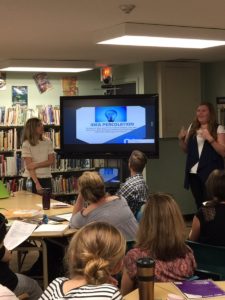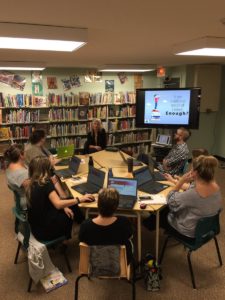Wait, didn’t we just do this two weeks ago?
Nope! We teased it two weeks ago when we said that,
For our next tour, I’m going to give you a taste of what the cohort of teachers working with Silvia Tolisano (our OJCS DocuMentors) have been working on. Stay tuned!
Well, as we head into our February Break with a Friday PD Day facilitated by our friends from NoTosh, this seems like a good opportunity to share out the amazing work our DocuMentors are doing. Which teachers are part of this cohort again?
Glad you asked!

We are so pleased to have a diverse (grade level, subject & experience) group of new teachers (folk who were not part of the NoTosh Design Team; excepting Melissa, Keren & me) who are learning new paradigms, NOW literacies and innovative skills and practices which are not only impacting their work, but the larger work of the school.
Don’t believe me? Well…let the tour begin!
“Cohort 2018” has a home page where you can see summaries and insights from Silvia herself. “Cohort 2018” has a landing page where you can get links to each teacher’s professional blog. That’s where the magic lies.
From Ann-Lynn’s Blog (click here for the full blog)
Who Own’s the Learning? Daily 5 Chronicles – Posted on January 27th
Daily 5 is a literacy framework that instills behaviors of independence, creates a classroom of highly engaged readers, writers, and learners, and provides teachers with the time and structure to meet diverse student needs. Because it holds no curricular content, it can be used to meet any school, district, state, or national standards. ~ The Daily Cafe
This week I asked myself, “Is the Daily 5 literacy framework allowing my students to achieve the ultimate goal?” Are they a classroom of highly engaged readers, writers and learners? Do they truly own their learning? As my Grade 2s completed their literacy block this past Wednesday morning and headed off to their next class, I remained in the empty classroom long enough to browse through my phone and look at some photos I had recently added. Were they just photos of compliant students doing what was asked of them, or did I have a classroom of students who now own their learning? Let’s examine four components of the Daily 5 and the photos which I believe captured my students owning their learning.
Work on Writing
I will confess, if I did not take a few minutes to quickly walk around the room and ask questions, I might have deleted these photos, not truly understanding the evidence I possessed in my photo album. In the photos below, both students were working on their writing, yet neither student was getting their inspiration from a class list of topics. One was very eager to complete a biography on a famous basketball player, Kawhi Leonard and another student was busy completing a narrative on a special family event. Yet a third student, who sadly will be leaving us in a few weeks, took this opportunity to write an account of her experience here in Canada for the past two years. Who owns the learning? They do!

Word Work
My students understand the importance of expanding their vocabulary. The photo below captures a student wanting to learn more and being self-motivated to do so. The student chose to spend our literacy block reading chapter 2 of our novel study “My Father’s Dragon”, stopping to jot down words she is unfamiliar with. I know I am hoping to see these vocabulary words added to our live dictionary on Flipgrid. The group photo below is evidence of two things; an example of Win Win, and a group of students who chose to play the competitive level of Osmo words. Before the Osmo spelling game could begin, however, the students had to resolve a conflict, brainstorming a solution where everyone wins.
Who owns the learning? They do!
Read to Self/Read to Someone
Finally, as all these wonderful things were taking place in my classroom, I had the opportunity to do some one-on-one conferencing with some students. Where were the others you ask? They took this opportunity to make a quick trip to the library to add to their book bins. They were using the Star Reading program to help them choose a “Just Right” book. This last photo in my post needs no words to describe what is taking place. But three words come to mind, highly engaged readers.

From Chelsea’s Blog, “The Chrysalis Chronicles” (click here for the full blog)
Feeling Sketchy? – Posted on January 17th
What is Sketchnoting? This is today’s topic on my learning journey with my cohort the DocuMentors with our in-house visit with Silvia Tolisano.
- Is drawing and doodling a story with pictures?
- Is it making my thoughts visible with symbols, pictures, arrows, ideas?
- Could this be a way I have my students take notes to enhance their thoughts and learning about how math concepts are related?
- Can I video/record the sketchnoting process (stop motion) to show my doodles and thoughts over time?
- How will sketchnoting change my learning?
- How will it change it and throw me to do something different?
- How am I going to take my examples and practices of sketchnoting and use it to sketchnote for learning?
These questions are running through my head as we gear up to begin this new learning process.
Opening up and getting ready to begin my first Sketchnote using the Paper app.
Doodling has a profound effect on creative problem-solving and deep information processing. ~ Suni Brown
On my third sketchnote…getting the hang of this..as we learn and “live” sketch…it’s hard…very hard… listening and sketching at the same time…
challenging my multi-tasking skills….
Let’s keep going….
…look at everyone else…
 They are doing so well! We are learning so much!
They are doing so well! We are learning so much!
…but…how am I feeling…this is going on too long…I’m feeling very uninterested…not by my lack of artistic skills (Tip #1 You don’t need to be an artist)…but I’m starting to tune out and not enjoy this process..but I’m hanging in there.
What does this tell or say about me?
First, that drawing may not be for me…but I’m open to try new things and work through it…
Second, that as much as I am a visual learner…I’d much rather express my own thoughts through words to communicate my output. This makes me think to a colleague sharing their learning DNA. I can have more than one learning competency, and this means; so can our students!
Back to more questions…now with some answers!
- would some of my students really enjoy this…YES!
- is it a skill that may be helpful and beneficial for some students to grow…YES!
- is this another avenue, tool, and skill to learn, and create from and with… YES!
So…back at it…and let’s try some more sketching…
I’m in this to learn…not just for me, but for my students…
Sketchnoting For…. This is it! This is why I’m continuing to do this…through my personal frustration and disengagement: for the students!
…to contribute, to give skills, to make meaning, to enhance memory, to tell a story, make connections, to reflect, to display content….to CREATE!
Here is my final sketchnote from…the big reveal…
10 Tips for Sketchnoting from a Sketch”novice”


I’ll continue to try sketching more…and provide an update of my progress.
If you want to try to sketchnote yourself, I encourage you to try it out! If you’re looking for inspiration and ideas.. check out the following places and links.
You may surprise yourself, learn something about yourself, and perhaps a new skill to surprise and encourage others!
#sketchnotes

From Shira’s Blog, “Finding the Light” (click here for the full blog)
Capturing Resilience – Posted on January 16th
Today the Documentors were invited into a Grade 3 math class with the goal of making learning visible. The students were assigned open-ended multiplication problems, and demonstrated their knowledge of 1 or 2 digit multiplication, using pictures, words, and numbers to demonstrate their thinking.
During the pre-documentation phase, I decided to focus on capturing the students resilience. How do they continue when they hit a barrier? What tools do they use? Do they persevere or do they give up? Resilience has been proven to be a strong measure of students success.
This trait is also attached to one of our school’s North Stars…We Own Our Own Learning.
The students were amazing! They were eager to get to work and tackled their problems with enthusiasm. Even with 9 extra adults in the room snapping photos, taking videos, and writing notes, they weren’t deterred. Even the first demonstration began with a student detailing how she began again as her first trial wasn’t working.
Then they broke into groups of two and the work began. It was beautiful to see the students working together, listening to each others ideas, and using trial and error multiple times to figure things out.
When some groups got stuck, they raised their hand for help or patiently waited for their teacher to come and support them. She reminded them to break the question down and use trial and error. They immediately got back to work.
I observed students continuing to work to figure out what was missing. They kept trying even though it was hard, and when one group felt down, with a little encouragement they continued to work with enthusiasm.
During the gallery walk we had a chance to ask the student leading questions. The resilience shone through in each and every group I spoke to.
When explaining her work, one student told me that there were lots of possibilities for the answers. I asked if she was finished and she said:
“There are still more possibilities. I am working on the math.”
Another pair explained that they tackled the problem by just starting to experiment different ways to solve the problem. When they got stuck their strategy was:
“We kept experimenting stuff.”
When there were problems one group said:
“We each did half.” When they got stuck, “We talked to each other, we erased it and did it another way.”
Was resilience evident?
ABSOLUTELY!

I want to share examples of Bethany, Josh, Melissa & Keren’s blogs as well – which I will do on our next tour – but you can view all their blogs by starting at the landing page and diving in.
Do you see how excited our teachers are about learning? Can you imagine how exciting it is for our students to have teachers like this?
We can! Because that is what life is (now) like at the Ottawa Jewish Community School.



















